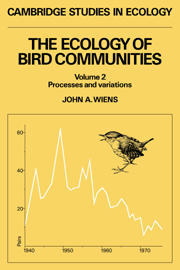6 - Concluding comments: future directions in avian community ecology
Published online by Cambridge University Press: 18 December 2009
Summary
In the past, avian ecologists documented simple patterns in communities and sought their explanations in the neat formulations of niche theory, Doing community ecology was exciting, fashionable, and fun. Increasingly, however, the complexity, variability, and ambiguity of nature have made community ecology more difficult and lessened its allure. In this and the previous volume, I have detailed a litany of problems, pitfalls, and perils that have plagued studies of avian communities. With the benefit of hindsight enriched by our increased awareness of the complexity of communities and the logical and methodological demands for doing science properly, it is easy to see where we may have gone astray. Such retrospection is useless, however, if we do not use it to redirect future activities in the discipline. We are faced with the prospect that many ecologists may become discouraged in their attempts to understand communities and will turn their attention to entirely different questions, while those who continue to study communities will become polarized into descriptive pattern-seekers or armchair theoreticians. In the meantime, the actual dynamics of communities may be left unattended because they are too fuzzy, too difficult to study, or not amenable to generalization or theory. We need to redirect our approach to community investigations in a way that will retain the excitement and satisfaction of the past yet not do violence to nature by oversimplification.
I attempt to provide some elements of this redirection in this chapter. Because theory is so central to our approach to community studies, I comment first on what we should expect of ecological theory. I then suggest some elements of future approaches to the study of bird communities.
- Type
- Chapter
- Information
- The Ecology of Bird Communities , pp. 251 - 264Publisher: Cambridge University PressPrint publication year: 1989



